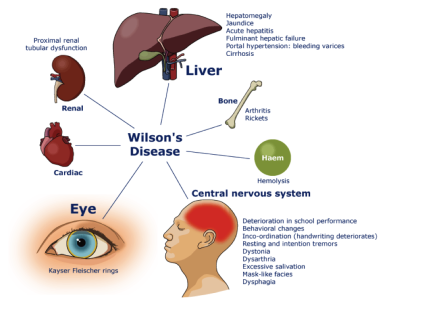Wilson’s disease is a copper poisoning of the liver and in the brain. The liver is unable to get rid of the copper contained in food. Copper is therefore accumulated in the body, mostly in the liver and the brain. The abnormity of the liver metabolism is caused by a deficiency in the genes. This deficiency is located to a precise location at chromosome no. 13 with the effect that the liver is unable to get rid of the copper absorbed by the intestine.
Although the deficiency is being inherited there are no symptoms, usually, the first five years and in most cases the symptoms are seen between the ages of 15 to 40.
Eventually the accumulated copper destroys the liver cells and is transported to other organs by the blood. The copper is deposited at a certain location in the brain the so-called basal ganglia, where it might cause different neurological symptoms. The copper is also deposited in the cornea of the eye. The copper forms a dark reddish ring encircling the edge of the cornea, the so-called KeyserFleischer ring.
In 1912 the disease was described by Wilson for the first time and was at that time called Hepatico-lenticular degeneration, i.e. changes in the liver and brain.
